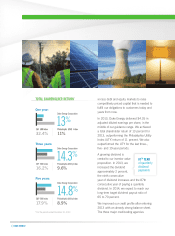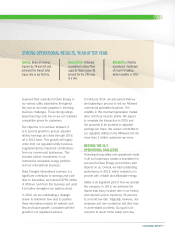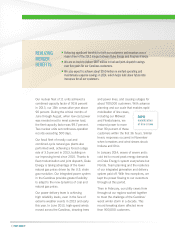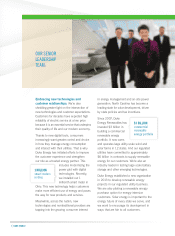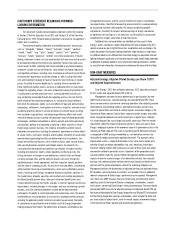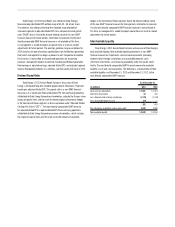Duke Energy 2013 Annual Report Download - page 16
Download and view the complete annual report
Please find page 16 of the 2013 Duke Energy annual report below. You can navigate through the pages in the report by either clicking on the pages listed below, or by using the keyword search tool below to find specific information within the annual report.
CAUTIONARY STATEMENT REGARDING FORWARD-
LOOKING INFORMATION
This document includes forward-looking statements within the meaning
of Section 27A of the Securities Act of 1933 and Section 21E of the Securities
Exchange Act of 1934. Forward-looking statements are based on management’s
beliefs and assumptions.
These forward-looking statements are identified by terms and phrases
such as “anticipate,” “believe,” “intend,” “estimate,” “expect,” “continue,”
“should,” “could,” “may,” “plan,” “project,” “predict,” “will,” “potential,”
“forecast,” “target,” “guidance,” “outlook” and similar expressions. Forward-
looking statements involve risks and uncertainties that may cause actual results
to be materially different from the results predicted. Factors that could cause
actual results to differ materially from those indicated in any forward-looking
statement include, but are not limited to: state, federal and foreign legislative
and regulatory initiatives, including costs of compliance with existing and future
environmental requirements or climate change, as well as rulings that affect
cost and investment recovery or have an impact on rate structures or market
prices; the ability to recover eligible costs, including those associated with
future significant weather events, and earn an adequate return on investment
through the regulatory process; the costs of decommissioning Crystal River Unit
3 could prove to be more extensive than is currently identified and all costs
may not be fully recoverable through the regulatory process; the risk that the
credit ratings of the combined company or its subsidiaries may be different
from what the companies expect; costs and effects of legal and administrative
proceedings, settlements, investigations and claims; industrial, commercial and
residential growth or decline in service territories or customer bases resulting
from customer usage patterns, including energy efficiency efforts and use of
alternative energy sources including self-generation and distributed generation
technologies; additional competition in electric markets and continued industry
consolidation; political and regulatory uncertainty in other countries in which
Duke Energy conducts business; the influence of weather and other natural
phenomena on operations, including the economic, operational and other effects
of severe storms, hurricanes, droughts and tornadoes; the ability to successfully
operate electric generating facilities and deliver electricity to customers; the
impact on facilities and business from a terrorist attack, cyber security threats,
data security breaches and other catastrophic events; the inherent risks
associated with the operation and potential construction of nuclear facilities,
including environmental, health, safety, regulatory and financial risks; the
timing and extent of changes in commodity price, interest rates and foreign
currency exchange rates and the ability to recover such costs through the
regulatory process, where appropriate, and their impact on liquidity positions
and the value of underlying assets; the results of financing efforts, including the
ability to obtain financing on favorable terms, which can be affected by various
factors, including credit ratings and general economic conditions; declines in
the market prices of equity securities and resultant cash funding requirements
for defined benefit pension plans, other post-retirement benefit plans, and
nuclear decommissioning trust funds; changes in rules for regional transmission
organizations, including changes in rate designs and new and evolving capacity
markets, and risks related to obligations created by the default of other
participants; the ability to control operation and maintenance costs; the level of
creditworthiness of counterparties to transactions; employee workforce factors,
including the potential inability to attract and retain key personnel; the ability
of subsidiaries to pay dividends or distributions to Duke Energy Corporation
holding company (the Parent); the performance of projects undertaken by our
nonregulated businesses and the success of efforts to invest in and develop
new opportunities; the effect of accounting pronouncements issued periodically
by accounting standard-setting bodies; the impact of potential goodwill
impairments; the ability to reinvest retained earnings of foreign subsidiaries
or repatriate such earnings on a tax free basis; and the ability to successfully
complete future merger, acquisition or divestiture plans.
Additional risks and uncertainties are identified and discussed in Duke
Energy’s and its subsidiaries’ reports filed with the SEC and available at the SEC’s
website at www.sec.gov. In light of these risks, uncertainties and assumptions, the
events described in the forward-looking statements might not occur or might occur
to a different extent or at a different time than Duke Energy has described. Forward
looking statements speak only as of the date they are made, Duke Energy undertakes
no obligation to publicly update or revise any forward-looking statements, whether
as a result of new information, future events or otherwise that occur after that date.
NON-GAAP MEASURES
Adjusted Earnings, Adjusted Diluted Earnings per Share (“EPS”)
and Adjusted Segment Income
Duke Energy’s 2013 Annual Report references 2013 adjusted earnings of
$3,071 million and adjusted diluted EPS of $4.35.
Management evaluates financial performance in part based on the non-
GAAP financial measures, adjusted earnings and adjusted diluted EPS. These
items are measured as income from continuing operations after deducting income
attributable to noncontrolling interests, adjusted for the dollar and per share
impact of special items and mark-to-market impacts of economic hedges in the
Commercial Power segment. Special items represent certain charges and credits,
which management believes will not be recurring on a regular basis, although
it is reasonably possible such charges and credits could recur. Mark-to-market
adjustments reflect the impact of derivative contracts, which are used in Duke
Energy’s hedging of a portion of the economic value of its generation assets in the
Commercial Power segment. The mark-to-market impact of derivative contracts
is recognized in GAAP earnings immediately as such derivative contracts do
not qualify for hedge accounting or regulatory treatment. The economic value
of generation assets is subject to fluctuations in fair value due to market price
volatility of input and output commodities (e.g. coal, electricity, natural gas).
Economic hedging involves both purchases and sales of those input and output
commodities related to generation assets. Operations of the generation assets
are accounted for under the accrual method. Management believes excluding
impacts of mark-to-market changes of the derivative contracts from adjusted
earnings until settlement better matches the financial impacts of the derivative
contract with the portion of economic value of the underlying hedged asset.
Management believes the presentation of adjusted earnings and adjusted diluted
EPS provides useful information to investors, as it provides them an additional
relevant comparison of Duke Energy’s performance across periods. Management
uses these non-GAAP financial measures for planning and forecasting and for
reporting results to the Board of Directors, employees, shareholders, analysts
and investors concerning Duke Energy’s financial performance. The most directly
comparable GAAP measures for adjusted earnings and adjusted diluted EPS are
Net Income Attributable to Duke Energy Corporation and Diluted EPS attributable
to Duke Energy Corporation common shareholders, which include the dollar and
per share impact of special items, mark-to-market impacts of economic hedges
in the Commercial Power segment and discontinued operations.


